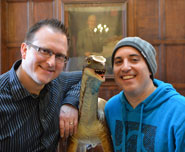The model is the work of local artist Robert Nicholls and University of Bristol dinosaur expert Pedro Viegas. It was constructed at M Shed during October and November, with more than 50,000 visitors dropping in to see the building process.
The recreation of Thecodontosaurus is the culmination of a three and a half year project run by the University of Bristol and funded by the Heritage Lottery Fund. The replica is based on the very latest scientific discoveries about how the dinosaur would have looked when it roamed around Bristol 210 million years ago.
Thecodontosaurus was first uncovered in a quarry on Durdham Down, Bristol in 1834 and was only the fourth dinosaur to be discovered in the world. Its bones are now on display at Bristol Museum & Art Gallery and M Shed. During the 1970s more bones were unearthed at a quarry in Tytherington, South Gloucestershire. These bones are now in the care of the University of Bristol. In 1999 the Bristol Dinosaur Project was founded to discover more about the bones.
Two earlier models of the dinosaur, dating from the 1980s, exist at the University of Bristol's School of Earth Sciences and a larger model, built in the 1970s, is currently on display in Bristol Museum & Art Gallery. Both models reflect earlier assumptions about the dinosaur – for instance, the mistaken belief that it was a carnivore – and the environment it would have lived in.
Advances in scientific knowledge since then have allowed researchers to study the remains in far greater detail and thus learn much more about how the dinosaur looked, walked and fed. For example, it was through detailed analysis of the dinosaur's teeth that scientists discovered Thecodontosaurus was actually a herbivore.
The dinosaur's scientific name, Thecodontosaurus antiquus, means 'ancient socket-toothed reptile'. It lived around 210 million years ago on warm, tropical islands around Bristol – part of a group of islands known as the Mendip Archipelago – a little like the Caribbean or the Seychelles today.
Thecodontosaurus was a small dinosaur, 2.5 metres long – about the size of a medium size dog such as a Labrador – with a long tail, powerful back legs and smaller front legs. It walked around on all fours but reached up into the trees with its front legs, using its claws to grab hold of the stems of prehistoric trees known as cycads. It had small sharp teeth, each with tiny sharp bumps running along one side – these made the teeth more like knives, able to tear through the thick, juicy leaves. The dinosaurs lived in small groups known as herds, with the male animals being larger than the females.
